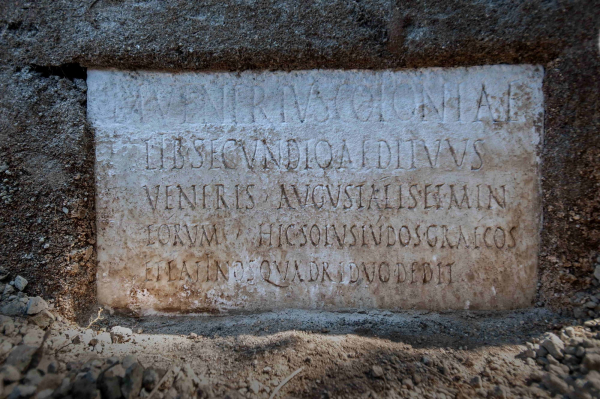Pompeii : Exceptionally well-preserved Burial discovered
Shortly before the volcano destroyed the city, a former slave was buried somewhat pompously. Marcus Venerius Secundio probably also had a soft spot for Greek theater. by Jan Dönges  Loading … © Parco Archaeologico di Pompei (detail)
Loading … © Parco Archaeologico di Pompei (detail)
Archaeologists have discovered an exceptionally well-preserved skeleton in Pompeii: the man who was named Marcus Venerius Secundio during his lifetime still has isolated gray hair and a bit of an ear. Remnants of fabric also cling to the corpse. “Nobody expected such an extraordinary find,” said the director of the Pompeii Archaeological Park Gabriel Zuchtriegel of the German Press Agency.
Marcus Venerius died shortly before the all-destructive eruption of Vesuvius in 79 AD. In that late phase of the city, most of the residents were cremated after their death. Venerius, who lived to be around 60 years old, had chosen a rather unusual funeral rite. The good state of preservation of his skeleton is due to the fact that his small burial chamber was hermetically sealed for two millennia.
The chamber was located on an arterial road in the city not far from Porta Sarno. With his quite stately tomb, the facade of which was once painted blue and green, the dead man underlined his high social position. An inscription reveals more about his life: According to this, Venerius was born a slave who served the community, but was later released. He worked as an overseer in the Temple of Venus. He was also a member of the Augustales' college of priests, who were responsible for the veneration of the deified emperor.
 Loading … © Parco Archaeologico di Pompei (detail) Graue Hair and a remnant of the ear | The skeleton is one of the best preserved from Pompeii.
Loading … © Parco Archaeologico di Pompei (detail) Graue Hair and a remnant of the ear | The skeleton is one of the best preserved from Pompeii.
The inscription closes with a remarkable detail: he put on shows in Latin and Greek that lasted four days. Park director Zuchtriegel explains that some performances in the theater were held in Greek so far. Now you have direct evidence of this. It shows how cosmopolitan and educated parts of the population of Pompeii were. Greek was used as a communication and educational language in ancient times. Members of the upper class in particular learned it at school.
Marcus Venerius Secundio is not entirely unknown: A person of the same name appears in the wax tablet archive of the banker Cecilius Giocondus, who had his financial institution in Via & nbsp; Vesuvio, writes the Pompeii Archaeological Park in a message about the find. His wife may also have been buried in the tomb of Venerius, at least two urns were found not far from the 1.60 by 2.40 meter large burial chamber. One of them contained a high quality glass container. A tombstone shows the name Novia Amabilis.
The textile remains from the grave are now to be examined for traces of targeted mummification. There may also be some form of embalming behind the corpse's good condition. “We know from the sources that certain textiles such as asbestos were used in embalming,” says the mummification expert Llorenç Alapont from the University of Valencia. The “extraordinary wealth of information” that this grave offers is extraordinary even for him, who has been dealing with the subject for a long time.
 Loading … © Pompeii Archaeological Park (detail) The tomb showed the prominent position of the buried | Archaeologists write that visitors to the city who passed the necropolis at the Porta Sarno city gate could not miss it.
Loading … © Pompeii Archaeological Park (detail) The tomb showed the prominent position of the buried | Archaeologists write that visitors to the city who passed the necropolis at the Porta Sarno city gate could not miss it.  Loading … © Pompeii Archaeological Park ( Detail) The inscription contains references to the life of the buried | Among other things, she reports on his (financial) commitment to the organization of plays.
Loading … © Pompeii Archaeological Park ( Detail) The inscription contains references to the life of the buried | Among other things, she reports on his (financial) commitment to the organization of plays.